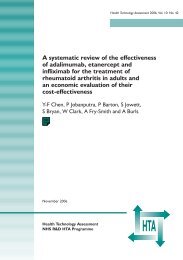Evaluation of liposomes coated with a pH responsive - University of ...
Evaluation of liposomes coated with a pH responsive - University of ...
Evaluation of liposomes coated with a pH responsive - University of ...
You also want an ePaper? Increase the reach of your titles
YUMPU automatically turns print PDFs into web optimized ePapers that Google loves.
1.0 Introduction<br />
Liposomes have been widely explored as drug delivery vehicles for several decades, <strong>of</strong>fering<br />
temporal control <strong>of</strong> drug release and/or site specific drug delivery for a wide range <strong>of</strong> drugs<br />
<strong>with</strong> different physiochemical properties. To date they have found clinical utility primarily<br />
for the treatment <strong>of</strong> severe systemic infections and cancer (Cattel et al., 2004), for which their<br />
parenteral delivery is necessary and appropriate. To further exploit the advantages associated<br />
<strong>with</strong> <strong>liposomes</strong> (e.g. their ability to interact <strong>with</strong> cells (Voskuhl and Ravoo, 2008), the<br />
relative ease in which they can be produced in a wide range <strong>of</strong> structural and compositional<br />
configurations (Lasic, 1998), their potential in gene transfection (Montier et al., 2008) and<br />
capacity to carry a vast array <strong>of</strong> chemical and biopharmaceutical drugs (Lasic, 1998) it is<br />
beneficial to explore formulations <strong>with</strong> potential for non-parenteral delivery. Indeed, a<br />
formulation suitable for oral drug delivery (widely accepted as the most practical, efficient<br />
and cost effective route for drug administration) could broaden the portfolio <strong>of</strong> applications<br />
for <strong>liposomes</strong> and open up several new avenues for treatment.<br />
Of growing interest generally in the world <strong>of</strong> oral drug delivery is colon-targeted delivery for<br />
treatment <strong>of</strong> both local and systemic conditions. It is recognised that this region <strong>of</strong> the<br />
gastrointestinal (GI) tract <strong>of</strong>fers advantages over the stomach and small intestine, e.g. milder<br />
<strong>pH</strong>, lower enzymatic activity, lower bile salt concentrations, longer residence time and slower<br />
turnover <strong>of</strong> the mucus layer. For biopharmaceutical delivery, it also appears to <strong>of</strong>fer the<br />
benefit <strong>of</strong> allowing greater functioning <strong>of</strong> absorption enhancers, thus allowing reasonable<br />
bioavailability <strong>of</strong> drugs such as peptides which would normally be poorly absorbed from the<br />
GI tract (Haupt and Rubinstein, 2002; Sinha et al., 2007).<br />
2
















